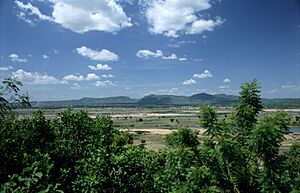Adamawa State facts for kids
Adamawa is one of the 36 states of Nigeria, located in the northeastern part of the country. Its capital city is Yola. Adamawa State is known for its beautiful natural scenery, including mountains and rivers, and for its many different cultural groups.
Contents
What is Adamawa State?
Adamawa State was created in 1991 from the former Gongola State. It shares borders with other Nigerian states like Gombe, Taraba, and Borno. It also shares an international border with the country of Cameroon to the east. This location makes Adamawa an important state for trade and cultural exchange.
Where is Adamawa located?
Adamawa State is in the northeastern region of Nigeria. It lies within the Benue River basin, which is a major river in West Africa. The state's geography includes plains, hills, and parts of the Mandara Mountains.
People and Culture
Adamawa State is home to many different ethnic groups, making it a very diverse place. Some of the major groups include the Fulani, Bachama, Bura, Higgi, and Marghi people. Each group has its own unique traditions, languages, and ways of life.
Languages spoken in Adamawa
While English is the official language of Nigeria, many local languages are spoken in Adamawa State. These include Fulfulde (spoken by the Fulani), Hausa, and various other languages specific to each ethnic group. This mix of languages shows the rich cultural tapestry of the state.
Festivals and traditions
People in Adamawa State celebrate many traditional festivals. These events often involve music, dance, and colorful costumes. They are a way for communities to celebrate their heritage, mark important seasons, or remember historical events. These festivals are a vibrant part of life in Adamawa.
Economy and Resources
The economy of Adamawa State is mainly based on farming. Many people grow crops like maize, millet, guinea corn, and rice. Fishing is also important, especially in areas near rivers and lakes.
Farming and agriculture
Agriculture is the backbone of Adamawa's economy. The fertile lands around the Benue River are excellent for growing food. Livestock farming, like raising cattle, goats, and sheep, is also common. These activities provide food and income for many families in the state.
Natural resources
Adamawa State has some natural resources, including deposits of clay, limestone, and gypsum. There are also forests that provide timber and other forest products. The state's rivers are important for fishing and can also be used for irrigation to help farms.
History of Adamawa
The area that is now Adamawa State has a long history. It was once part of various ancient kingdoms and empires. The Fulani people established the Adamawa Emirate in the 19th century, which became a powerful kingdom in the region.
How Adamawa State was formed
Adamawa State was created on August 27, 1991. It was carved out of the former Gongola State, along with Taraba State. This was part of a larger effort by the Nigerian government to create more states and bring government closer to the people.
The Capital City: Yola
Yola is the capital city of Adamawa State. It is a major center for trade, education, and government in the state. Yola is located on the Benue River, which has historically made it an important trading post.
Important places in Yola
Yola is home to several important places. These include the Adamawa State Government House, various markets, and educational institutions like the Federal University of Technology, Yola. The city also has a rich history, with old buildings and historical sites.
Images for kids
See also
 In Spanish: Estado de Adamawa para niños
In Spanish: Estado de Adamawa para niños




